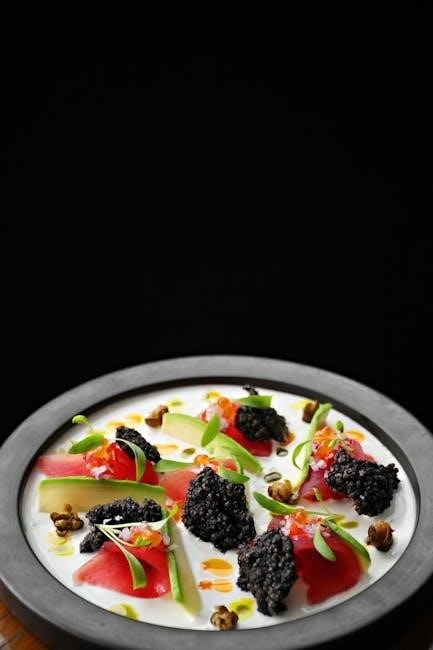5 mother sauces pdf
Summary
Unlock the secrets of French cooking with the 5 mother sauces. Learn recipes, tips, and how to elevate your dishes!

The 5 Mother Sauces are the foundation of French cuisine‚ providing a framework for countless classical dishes. Introduced by Marie-Antoine Carême and later refined by Auguste Escoffier‚ these sauces—Béchamel‚ Velouté‚ Espagnole‚ Tomate‚ and Hollandaise—offer a versatile base for both traditional and modern cooking. Mastering them is essential for understanding sauce preparation and elevating culinary skills.
Definition and Importance in French Cuisine
The 5 Mother Sauces are the cornerstone of French culinary technique‚ representing foundational recipes from which countless derivatives are created. These sauces—Béchamel‚ Velouté‚ Espagnole‚ Tomate‚ and Hollandaise—provide a standardized approach to sauce preparation‚ ensuring consistency and versatility in both classical and modern cooking.
Their importance lies in their ability to enhance dishes while maintaining balance and harmony of flavors. Each mother sauce serves as a canvas for creativity‚ allowing chefs to adapt them to various ingredients and cooking methods. This system‚ refined by Auguste Escoffier‚ revolutionized French cuisine by simplifying complex preparations into manageable‚ scalable processes.
Understanding these sauces is essential for any culinary professional‚ as they form the backbone of French gastronomy. They are not only tools for creating delicious dishes but also a testament to the elegance and precision of French culinary tradition‚ inspiring innovation while preserving timeless techniques.
Historical Background: Marie-Antoine Carême and Auguste Escoffier

The concept of the 5 Mother Sauces was first introduced by Marie-Antoine Carême‚ a French chef often regarded as the “Father of French Cuisine‚” in the early 1800s. He sought to organize French cooking into a systematic framework‚ simplifying it into basic categories. Later‚ Auguste Escoffier‚ another culinary legend‚ refined and popularized these sauces in the early 20th century‚ formalizing the list to include Béchamel‚ Velouté‚ Espagnole‚ Tomate‚ and Hollandaise. Carême’s work laid the groundwork for Escoffier’s revisions‚ which further elevated the prominence of these sauces in classical French cuisine. Together‚ their contributions established the Mother Sauces as the cornerstone of culinary education and practice‚ influencing French and international cooking to this day.
Béchamel Sauce

Béchamel is a white sauce made from milk‚ butter‚ and flour‚ forming a smooth‚ creamy base. It’s versatile and used in dishes like lasagna and gratins‚ showcasing its adaptability in both classic and modern recipes.
Ingredients and Basic Preparation
Béchamel sauce begins with a white roux‚ made by melting 2 tablespoons of butter and whisking in 2 tablespoons of all-purpose flour. Cooked for 2-3 minutes‚ the roux is lightly toasted to remove any raw flavor. Gradually‚ 1 cup of milk is added‚ whisking continuously to prevent lumps. The mixture is brought to a gentle simmer‚ then reduced to a low heat for 5-10 minutes‚ stirring occasionally‚ until it thickens into a smooth‚ velvety texture. Seasoning with salt‚ pepper‚ and a pinch of nutmeg enhances the flavor. This basic preparation serves as a canvas for various derivatives‚ making Béchamel a cornerstone in French cuisine.

Common Derivatives: Cream Sauce‚ Mornay Sauce‚ and More
Béchamel sauce serves as a versatile base for numerous derivatives‚ each offering unique flavors. Cream Sauce is created by adding heavy cream‚ enriching the texture and taste. Mornay Sauce incorporates grated cheese‚ typically Gruyère or Parmesan‚ making it ideal for pasta‚ vegetables‚ or gratins. Other variations include Soubise Sauce‚ infused with caramelized onions for a sweet and savory profile‚ and Nantua Sauce‚ featuring crayfish and mushrooms for a luxurious touch. Additionally‚ Cheddar Cheese Sauce and Mustard Sauce are popular for their bold‚ tangy flavors. These derivatives showcase the adaptability of Béchamel‚ allowing chefs to craft a wide array of dishes with ease and creativity.

Velouté Sauce
Velouté Sauce is a smooth‚ creamy mother sauce made with blond roux and light stock‚ known for its delicate flavor and versatility in dishes like chicken or fish sauces.

Ingredients and Cooking Techniques
Velouté Sauce is crafted with a blond roux (butter and flour) and a light stock‚ such as chicken or fish. The roux is cooked briefly to retain its pale color and delicate flavor. Gradually‚ warm stock is whisked in to create a smooth‚ velvety texture. The mixture is simmered gently to cook out the raw taste of the flour‚ ensuring a refined finish. Seasonings like salt‚ pepper‚ and a touch of nutmeg are often added for depth. The sauce is strained to remove any impurities‚ resulting in a luminous appearance. Its light‚ creamy consistency makes it a versatile base for dishes like chicken or fish sauces‚ offering a subtle yet elegant flavor profile. This technique demonstrates the importance of precision and patience in sauce preparation.
Popular Variations and Pairings
Velouté Sauce offers a canvas for creative variations‚ with additions like cream‚ herbs‚ or wine enhancing its flavor. One popular derivative is Suprême Sauce‚ made by enriching Velouté with heavy cream and serving it alongside poultry or vegetables. Another variation is Albufera Sauce‚ which incorporates foie gras and truffles for a luxurious touch‚ often paired with meats or pasta. Velouté also pairs beautifully with delicate fish‚ such as sole‚ or as a base for creamy vegetable sauces. Its light‚ refined texture makes it a versatile companion for dishes requiring subtle‚ elegant flavor. By experimenting with additional ingredients‚ chefs can adapt Velouté to suit various culinary needs‚ showcasing its timeless versatility in modern and traditional cuisine alike.

Espagnole Sauce
Espagnole Sauce is a rich‚ dark sauce made with brown roux‚ beef or veal stock‚ and browned bones‚ forming the base for many classical French dishes and demi-glace.

Ingredients and Traditional Preparation
Espagnole Sauce begins with a dark roux‚ made by slowly cooking butter and flour until it reaches a deep amber color. This roux is then combined with a rich brown stock‚ traditionally made from beef or veal bones that have been roasted to enhance their flavor. The mixture is simmered for an extended period‚ often several hours‚ to extract the deep‚ caramelized flavors from the bones and vegetables like carrots‚ celery‚ and onions. Seasonings such as bay leaves and thyme are added to complement the sauce’s robust profile. The result is a thick‚ velvety texture with a deep‚ slightly sweet and umami-rich flavor‚ forming the foundation for numerous derivative sauces and the iconic demi-glace.
Demi-Glace and Its Uses
Demi-Glace is a concentrated reduction of Espagnole Sauce‚ resulting in a rich‚ velvety‚ and intensely flavorful glaze. Traditionally‚ it is made by simmering Espagnole for hours until it reaches a thick‚ syrupy consistency. This process enhances the sauce’s deep‚ caramelized flavors‚ making it a cornerstone in fine dining. Demi-Glace is often used as a finishing sauce for dishes like roasted meats‚ game‚ or root vegetables‚ adding a luxurious touch. It can also serve as a base for smaller sauces‚ such as Robert or Péché‚ by incorporating additional ingredients like mustard or herbs. In modern kitchens‚ Demi-Glace is valued for its versatility and ability to elevate dishes with its robust‚ umami-rich profile‚ making it a timeless element in French culinary tradition.
Tomate Sauce
Tomate Sauce‚ made with fresh tomatoes‚ onions‚ and herbs‚ is simmered to concentrate flavors. A base for Provençale‚ Arrabbiata‚ and Andalouse‚ it adds vibrant acidity and depth to dishes.
Ingredients and Cooking Methods
Tomate Sauce begins with fresh tomatoes‚ onions‚ garlic‚ and herbs like bay leaves and thyme. The ingredients are sautéed to soften‚ then simmered until thickened. For a richer flavor‚ a small amount of blond roux is sometimes added to thicken the sauce. The slow cooking process enhances the natural sweetness of the tomatoes‚ creating a robust base. Some recipes incorporate tomato paste for intensity‚ especially when fresh tomatoes are out of season. The sauce is seasoned with salt‚ pepper‚ and occasionally a pinch of sugar to balance acidity. Proper cooking ensures a smooth texture and deep flavor‚ making it a versatile foundation for various dishes. This method ensures the sauce retains its vibrant color and bold taste‚ essential for authentic French culinary applications.
Modern Adaptations and Variations
While traditional Tomate Sauce remains a cornerstone‚ modern chefs have introduced creative twists to enhance its versatility. Contemporary variations often incorporate fresh or heirloom tomatoes for vibrant flavors‚ while others blend in spices like smoked paprika or chipotle peppers for a smoky touch. Some recipes substitute tomato paste with roasted tomatoes to reduce acidity and deepen richness. International influences‚ such as adding Asian-inspired ginger or Middle Eastern cumin‚ offer unique flavor profiles. Additionally‚ plant-based adaptations use vegan-friendly ingredients‚ catering to modern dietary preferences. These innovations allow Tomate Sauce to complement a broader range of dishes‚ from pasta to grilled meats‚ while maintaining its classic charm. Such adaptations ensure the sauce remains relevant in evolving culinary landscapes‚ bridging tradition with contemporary tastes.

Hollandaise Sauce
Hollandaise Sauce is a rich‚ velvety emulsion of egg yolks‚ butter‚ and lemon juice‚ perfect for dishes like eggs Benedict. Its creamy texture enhances various culinary creations.
Ingredients and Emulsification Process
Hollandaise Sauce is made with egg yolks‚ melted butter‚ lemon juice‚ and a pinch of salt‚ with optional additions like cayenne pepper for flavor. The emulsification process involves tempering the egg yolks by slowly whisking in warm‚ melted butter‚ creating a smooth‚ creamy texture. This step requires precision to prevent the sauce from breaking. The mixture is typically cooked over low heat or in a double boiler to stabilize the emulsion. Continuous whisking ensures the sauce remains velvety and uniform. The process begins with a base of egg yolks and lemon juice‚ gradually incorporating the butter to achieve the desired consistency. Maintaining the right temperature is crucial to avoid curdling. This traditional method is a cornerstone of French cuisine‚ showcasing the art of sauce-making. The result is a rich‚ indulgent sauce perfect for enhancing dishes like eggs Benedict or asparagus.
Common Derivatives: Maltaise and Choron Sauces
Maltaise and Choron sauces are two popular derivatives of Hollandaise‚ each offering unique flavor profiles. Maltaise sauce is created by infusing Hollandaise with orange juice and zest‚ adding a vibrant citrus note. Choron sauce‚ on the other hand‚ incorporates tomato purée‚ which gives it a tangy‚ slightly sweet flavor. Both variations are versatile and elevate dishes like seafood‚ eggs Benedict‚ and vegetables. Maltaise pairs beautifully with asparagus or fish‚ while Choron complements meats such as steak or poultry. These sauces demonstrate the adaptability of the Hollandaise base‚ allowing chefs to experiment with flavors while maintaining the luxurious texture. Their creation highlights the importance of creativity in sauce-making‚ building on the foundational techniques of the mother sauces. These derivatives are celebrated in modern cuisine for their bold twists on a classic.
The 5 Mother Sauces form the cornerstone of French cuisine‚ offering timeless versatility. Mastering these foundations empowers chefs to create countless variations‚ ensuring their relevance in modern cooking. Essential for culinary excellence‚ they endure as a testament to classical technique and innovation.
The Role of Mother Sauces in Modern Cooking
Mother sauces continue to play a pivotal role in modern cuisine‚ serving as the backbone for countless contemporary dishes. Their versatility allows chefs to adapt traditional recipes to current tastes‚ experimenting with new ingredients while maintaining the foundational techniques. For instance‚ Béchamel can be transformed into a creamy vegan version by substituting dairy with plant-based alternatives. Similarly‚ Espagnole’s rich‚ umami flavor is now often enhanced with global spices‚ catering to diverse palates. These sauces not only enhance flavor profiles but also provide a bridge between classical and innovative cooking. Their enduring relevance lies in their ability to evolve‚ ensuring they remain integral to both haute cuisine and casual dining. By mastering these bases‚ chefs can effortlessly innovate‚ keeping culinary traditions alive while pushing creative boundaries.

Final Thoughts on Mastering the Basics
Mastering the 5 Mother Sauces is an essential skill for any aspiring chef or home cook‚ as they form the backbone of classical and modern cuisine. These foundational sauces—Béchamel‚ Velouté‚ Espagnole‚ Tomate‚ and Hollandaise—provide a gateway to endless creativity and innovation in the kitchen. By understanding their preparation and versatility‚ cooks can expand their culinary repertoire‚ adapting traditional techniques to contemporary tastes. Consistent practice and attention to detail are key to perfecting these sauces‚ as they rely on precise methods like roux preparation and emulsification. Once mastered‚ these sauces open doors to countless derivatives and variations‚ enabling chefs to craft dishes that are both elegant and flavorful. The art of sauce making is a timeless skill‚ and these Mother Sauces remain a testament to the enduring principles of French culinary excellence.